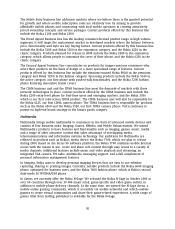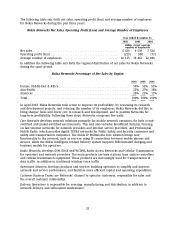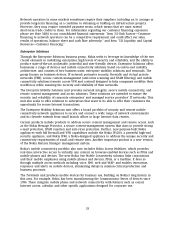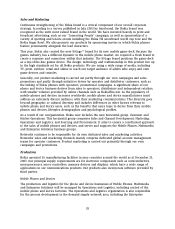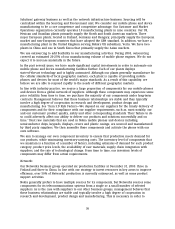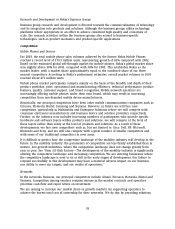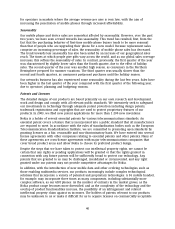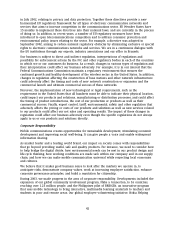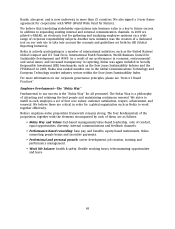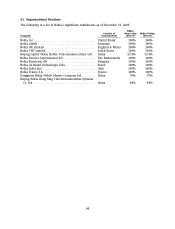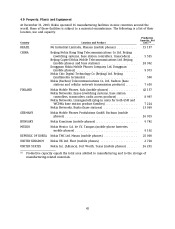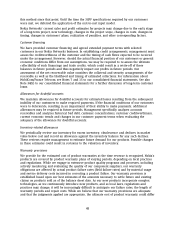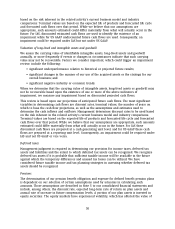Nokia 2003 Annual Report Download - page 41
Download and view the complete annual report
Please find page 41 of the 2003 Nokia annual report below. You can navigate through the pages in the report by either clicking on the pages listed below, or by using the keyword search tool below to find specific information within the annual report.for operators in markets where the average revenue per user is very low, with the aim of
increasing the penetration of mobile phones through increased affordability.
Seasonality
Our mobile phone and device sales are somewhat affected by seasonality. However, over the past
two years, we have seen a trend towards less seasonality. This trend has resulted, first, from the
fact that the purchasing behavior of first-time mobile phone buyers tends to be more seasonal
than that of people who are upgrading their phone for a new model. Because replacement sales
comprise an increasing percentage of sales, the seasonality of mobile phone sales has decreased.
The trend towards less seasonality has also been aided by an increase of our geographical sales
reach. The times at which people give gifts vary across the world, and as our global sales coverage
increases, this softens the seasonality of sales. In contrast, previously, the first quarter of the year
was characterized by slightly lower sales than the fourth quarter, due to the effect of holiday
sales. The second quarter of the year was another high season, as consumers in the Northern
Hemisphere prepared for summer vacations. The third quarter was usually slower than the
second and fourth quarters, as consumers postponed purchases until the holiday season.
Our networks business has also experienced some seasonality during the last few years. Sales have
been higher in the last quarter of the year compared with the first quarter of the following year,
due to operators’ planning and budgeting reasons.
Patents and Licenses
The detailed designs of our products are based primarily on our own research and development,
work and design and comply with all relevant public standards. We intensively seek to safeguard
our investments in technology through adequate patent protection including design patents,
trademark registrations and copyrights that are used to protect proprietary features of our
products. In 2003, we filed new patent applications for more than 1 200 new inventions.
Nokia is a holder of several essential patents for various telecommunications standards. An
essential patent covers a feature that is incorporated into a public standard that all manufacturers
are required to meet. In accordance with the rules of standardization bodies such as the European
Telecommunication Standardization Institute, we are committed to promoting open standards by
granting licenses on a fair, reasonable and non-discriminatory basis. We have entered into several
license agreements with other companies relating to essential patents and other patents. Many of
these agreements are cross-license agreements with major telecommunications companies that
cover broad product areas and allow Nokia to choose its preferred product design.
Despite the steps that we have taken to protect our intellectual property rights, we cannot be
certain that any rights or pending applications will be granted or that the rights granted in
connection with any future patents will be sufficiently broad to protect our technology. Any
patents that are granted to us may be challenged, invalidated or circumvented, and any right
granted under our patents may not provide competitive advantages for Nokia.
In addition, with the introduction of new mobile data and other evolving technologies, such as
those enabling multimedia services, our products increasingly include complex technological
solutions that incorporate a variety of patented and proprietary technologies. A 3G mobile handset,
for example, may incorporate three times as many components, including substantially more
complex software, as our GSM phones. As the number of entrants in the market grows, as the
Nokia product range becomes more diversified, and as the complexity of the technology and the
overlap of product functionalities increase, the possibility of an infringement and related
intellectual property claim against us increases. The holders of patents relevant to our products
may be unknown to us or make it difficult for us to acquire licenses on commercially acceptable
40


